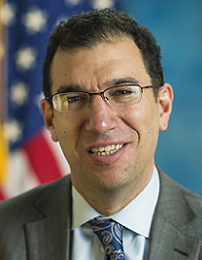 By Andy Slavitt, Acting Administrator, Centers for Medicare & Medicaid Services
By Andy Slavitt, Acting Administrator, Centers for Medicare & Medicaid Services
Twitter: @CMSgov
Recently, prescription drugs have been in the news a lot, particularly with respect to their cost. Millions of Americans rely on prescription medications to manage chronic illnesses or treat acute conditions, and drug innovation has resulted in better health outcomes for people across our nation. Because of this, finding ways to improve affordability and access for patients, supporting and increasing innovation in the industry, and – most importantly – making people healthier has become an area of significant interest to many.
As medicines become more precise and targeted, there is the potential to develop new generations of therapies that enable interventions to be better tailored to groups of people and even individuals. Medications in the future can improve health outcomes for many diseases such as cancer and Alzheimer’s, and help us better manage our chronic conditions like diabetes, heart disease and depression, providing significant benefits to patients across the country.
In order to have the maximum impact, medications must also be affordable and accessible. This is an important issue for Americans and for patients, businesses, and governments. Surveys suggest that as many as 25 percent of Americans cannot afford and, therefore, do not fill the prescriptions on which they depend. And, spending on medicines increased 13 percent in 2014, compared to 5 percent for health care spending growth overall, the highest rate of drug spending growth since 2001. An important element of this increase in costs is due to new specialty drugs — drugs that account for nearly a third of overall costs, but represent less than 1 percent of prescriptions.
Cost concerns aren’t only limited to brand-name medicines. In some instances, the prices of generics available for years have increased substantially without any additional health benefits for patients. This is a concern across the country, but particularly for consumers on fixed incomes. The Bipartisan Budget Act, just signed into law by President Obama, provides Medicaid with additional rebates if generic drug prices grow faster than inflation, which will discourage manufacturers from increasing prices for generic drugs.
The rhetoric around health care costs can become heated, particularly around the cost of prescription drugs. At times, it can appear as if some of those who produce the pharmaceuticals and those whose lives often depend on them have unaligned interests. But we will not make progress by polarizing this debate. Development of ground-breaking therapies requires significant investment and resources, and we all need to support that important work. We believe patients, manufacturers, providers, insurers and government all share a common goal to foster a health care system that leads in innovation, delivers affordable, high quality medicines, and results in healthier people with access to the care they need. We shouldn’t accept the notion that we as a society must choose between innovation and affordability. We deserve both.
A recent example of a much discussed, highly-effective drug is a therapy used by Hepatitis C patients. Hepatitis C, a debilitating and life threatening infection that leads to chronic conditions of the liver, has undergone a revolutionary improvement in cure rates with innovative new medicines. These medicines are changing the lives of many individuals, but they are also expensive, costing tens of thousands of dollars, sometimes even more than one hundred thousand dollars, per patient. These costs have strained personal as well as public budgets, particularly state health care budgets. Because state budgets generally need to be balanced every year, new drug treatments can surprise states with tens or hundreds of millions of dollars in new spending. As these costs often necessarily compete with other state programs like K-12 education, transportation, law enforcement, and public health programs, some states have made tough choices, including limiting access to these therapies.
Recognizing that we need both access and affordability, we issued a notice to all 50 state Medicaid directors and sent letters to the CEOs of several drug manufacturers about providing access to therapy for Hepatitis C patients. Our notice to state Medicaid directors reminds states of their obligation to provide access to these promising therapies (consistent with section 1927 of the Social Security Act) based on the medical evidence, and that they have tools available to manage their costs. Our letter to manufacturers asks them to provide us with information on pricing arrangements and asks them for ideas to support the provision of these lifesaving medications to Medicaid programs at sustainable prices.
There are no easy answers to these multifaceted challenges, but there is a significant benefit – to all of us – of working together to find a solution. Earlier this week, Secretary of Health & Human Services Sylvia Burwell invited leaders in innovation, policy, care delivery, academia, manufacturing, purchasing, and patient advocacy to share information at a public meeting on how to achieve our common goals.
These are complex issues, and we recognize that the public is relying on our leadership. We will work to ensure that all viewpoints are considered as we strive for solutions. In the end, we share a common goal of supporting innovation and improving affordable access to medications that improve health outcomes for patients.
This article was originally published on The CMS Blog and is republished here with permission.
